A) I
B) II
C) III
D) Equal amounts of I and IV.
E) Equal amounts of II and IV.
Correct Answer

verified
Correct Answer
verified
Multiple Choice
The reaction of benzene with  in the presence of anhydrous aluminum chloride produces principally which of these?
in the presence of anhydrous aluminum chloride produces principally which of these? 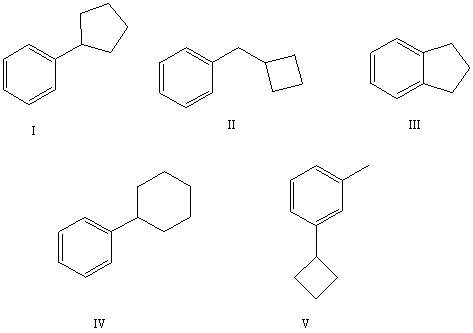
A) I
B) II
C) III
D) IV
E) V
Correct Answer

verified
Correct Answer
verified
Multiple Choice
Which reagent(s) would you use to carry out the following transformation? t-butylbenzene p-chloro substitution product
A) Cl2,light,and heat
B) Cl2,FeCl3
C) SOCl2
D) C2H5Cl,AlCl3
E) HCl,peroxide
Correct Answer

verified
Correct Answer
verified
Multiple Choice
Which is the best sequence of reactions for the following transformation? 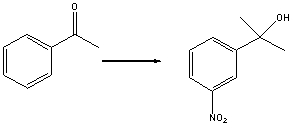
A) i) HNO3,H2SO4; ii) CH3MgBr,Et2O; iii) H2O,NH4Cl
B) i) CH3MgBr,Et2O; ii) H3O+,heat; iii) HNO3,H2SO4
C) i) HNO3,H2SO4; ii) NaBH4,H2O; iii) H3O+,heat
D) i) HNO3,H2SO4; ii) LiAlH4,H2O; iii) H3O+,heat
E) None of these syntheses is satisfactory.
Correct Answer

verified
Correct Answer
verified
Multiple Choice
Which reagent would you use as the basis for a simple chemical test that would distinguish between toluene and vinylbenzene (C6H5CH=CH2) ?
A) NaOH/H2O
B) Br2/CCl4
C) NaBH4
D) HCl/H2O
E) NaI in acetone
Correct Answer

verified
Correct Answer
verified
Multiple Choice
Which reagent or test could you use to distinguish between phenylacetylene and vinylbenzene?
A) NaOH/H2O
B) Br2/CCl4
C) IR Spectroscopy
D) CrO3/H2SO4
E) Concd.H2SO4
Correct Answer

verified
Correct Answer
verified
Multiple Choice
Which of the following reactions would yield isopropylbenzene as the major product?
A) ![]()
B) ![]()
C) ![]()
D) ![]()
E) All of these choices.
Correct Answer

verified
Correct Answer
verified
Multiple Choice
Toluene is subjected to the action of the following reagents in the order given: (1) KMnO4,OH-,heat; then H3O+ (2) HNO3,H2SO4 (3) Br2,FeBr3 What is the final product of this sequence? 
A) I
B) II
C) III
D) IV
E) V
Correct Answer

verified
Correct Answer
verified
Multiple Choice
The major product,D,of the following reaction, 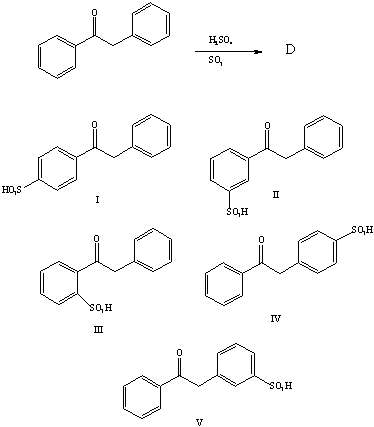 would be:
would be:
A) I
B) II
C) III
D) IV
E) V
Correct Answer

verified
Correct Answer
verified
Multiple Choice
When toluene is reacted in turn with 1) Cl2 (large excess) ,heat,and light and 2) Br2,FeBr3,the chief product is: 
A) I
B) II
C) III
D) IV
E) A mixture of III and IV.
Correct Answer

verified
Correct Answer
verified
Multiple Choice
What reagent can effect the following transformation? 
A) CO2; then H3O+
B) H3O+,heat
C) Mg; then CO2; then H3O+
D) H2O2,heat
E) KMnO4,OH-,heat; then H3O+
Correct Answer

verified
Correct Answer
verified
Essay
Suggest a reasonable synthetic strategy for the synthesis of 4-methyl-1-phenyl-1-pentanol from 4-methylpentanoyl chloride,(CH3)2CHCH2CH2COCl
Correct Answer

verified
Correct Answer
verified
Multiple Choice
What product would result from the following series of reactions, 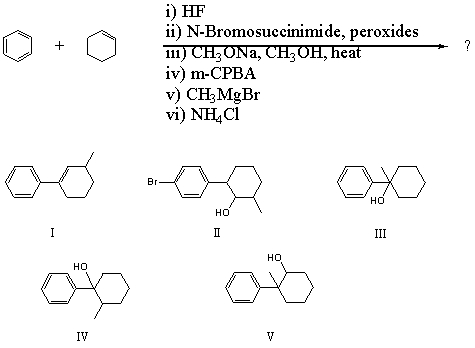
A) I
B) II
C) III
D) IV
E) V
Correct Answer

verified
Correct Answer
verified
Multiple Choice
Which of the following compounds would be least reactive toward electrophilic substitution? 
A) I
B) II
C) III
D) IV
E) V
Correct Answer

verified
Correct Answer
verified
Short Answer
With the exception of halogens,activating groups are ___ directors and deactivating groups are ___ directors.
Correct Answer

verified
Correct Answer
verified
Essay
Based on your knowledge of electrophilic aromatic substitution,predict the position of attack of an electrophile on pyridine,i.e.,does the electrophile E+ attack carbon 2,3,or 4? Explain your answer.  Which substitution product(s)forms and why?
Which substitution product(s)forms and why?
Correct Answer

verified
The 3 substitution product is ...View Answer
Show Answer
Correct Answer
verified
View Answer
Multiple Choice
Which would be the product,X,of the following reaction sequence? 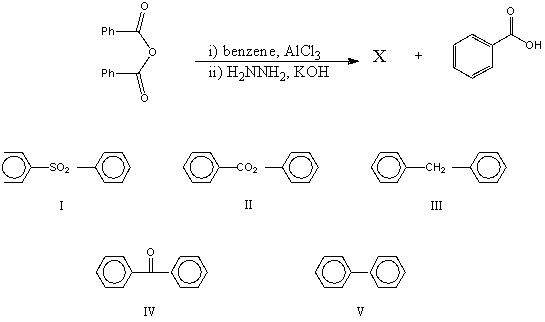
A) I
B) II
C) III
D) IV
E) V
Correct Answer

verified
Correct Answer
verified
Essay
Using a potential energy diagram,explain/illustrate the preferential formation of the 3 substituted product instead of the 2 product in the electrophilic aromatic substitution of indole (shown). 
Correct Answer

verified
3-substitution is preferred,since this l...View Answer
Show Answer
Correct Answer
verified
View Answer
Multiple Choice
What would be the major product of the following reaction? 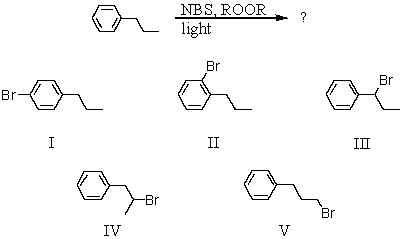
A) I
B) II
C) III
D) IV
E) V
Correct Answer

verified
Correct Answer
verified
Multiple Choice
Which reagent(s) would you use to carry out the following transformation? isopropylbenzene 2- and 4-chloro-1-isopropylbenzene
A) Cl2,light,and heat
B) Cl2,FeCl3
C) SOCl2
D) C2H5Cl,AlCl3
E) HCl,peroxides
Correct Answer

verified
Correct Answer
verified
Showing 161 - 180 of 207
Related Exams